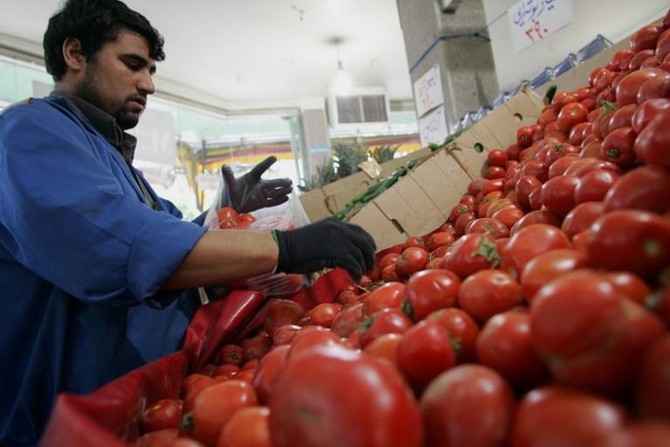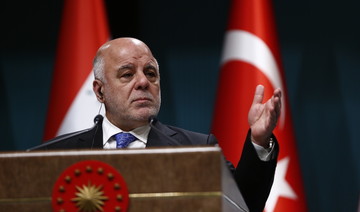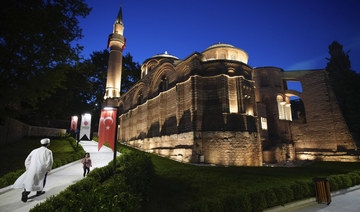DUBAI/LONDON: Tomato paste is not the most obvious economic indicator, but in Iran, where it is a staple that some people have started panic-buying, it says a lot about the impact of renewed US sanctions.
While Iran makes its own paste from an abundant crop of locally grown tomatoes, sanctions reimposed by US President Donald Trump since August have played havoc with supply.
A 70 percent slide in the rial this year has prompted a scramble for foreign currency that has made exports much more valuable in local terms than selling produce at home.
Some shops are limiting purchases of tomato paste, which is used in many Persian dishes, and some lines have sold out as people buy up existing stock.
The government has responded by banning tomato exports, one of a raft of interventions to try to limit economic instability that has fueled public protests and criticism of the government this year.
But the tomato policy is not working. An industry representative said tomatoes were being smuggled abroad.
“We have heard that trucks full of tomatoes are still leaving the country, especially to Iraq,” Mohammad Mir-Razavi, head of the Syndicate of Canning Industry, said by telephone.
“They put boxes of greenhouse tomatoes on top and hide normal tomatoes at the bottom,” he said, referring to an exemption for hot-house grown tomatoes that left a loophole.
It is one of many ways in which the sanctions are hurting ordinary Iranians while benefiting those with access to hard currency.
Washington reintroduced steps against Iran’s currency trade, metals and auto sectors in August after the US withdrawal from a deal that lifted sanctions in return for limits on Iran’s nuclear program. Trump said the deal was not strict enough.
With US curbs on Iran’s oil exports set to come into force next month, some Iranians fear their country is entering an economic slump that may prove worse than the period from 2012 to 2015, when it last faced major sanctions.
“There is an emerging consensus that the economy will go through a period of austerity similar to that recorded during the Iran-Iraq war,” said Mehrdad Emadi, an Iranian economist who heads energy risk analysis at London’s Betamatrix consultancy.
Jumps in prices are occurring in a range of goods — particularly imports such as mobile telephones and other consumer electronics, but also some staples. A bottle of milk, 15,000 rials last year, now sells for 36,000.
An 800-gram (28-ounce) can of tomato paste was selling in Tehran stores for around 60,000 rials in March; it is now 180,000 rials, or $1.24 at the unofficial rate, prompting a scramble by households to stock up. The price of tomatoes has increased more than five-fold compared to last year.
Signs on the shelves of some stores limit each customer to two cans. Iranian online shopping site Digikala lists the top nine tomato paste items as out of stock, and the rest as “coming soon.” In supermarkets in Najaf in neighboring Iraq, meanwhile, supplies of Iranian tomato paste are plentiful.
Adding to the pressure is a fourfold rise in the price of cans, Mir-Razavi said. Traders importing material to make cans sought to buy dollars at a little-used official rate of 42,000 rials; authorities asked them to use a more expensive rate. The issue has delayed shipments of material to factories.
The government is mounting a campaign against price-gouging, periodically ordering shopkeepers to sell at lower prices. But some shopkeepers respond by not selling at all, believing prices will eventually rise again as the sanctions bite.
Iran, a big oil producer with a diverse economy, has shown its farming, manufacturing and distribution sectors can ride out long periods of war and sanctions.
The Tehran Stock Exchange index has soared 83 percent this year as shares of exporting companies have rocketed. Urban real estate prices have also risen as Iranians plow their savings into property rather than keeping them in depreciating rials.
The rial’s plunge, which in the unofficial market has taken it to around 145,000 against the dollar from 42,890 at the end of 2017, according to currency tracking website bonbast.com, may even have strengthened the financial system in one way.
Banks and pension funds have been struggling with massive debts. Emadi said the rial’s slide, to as low as 190,000 in late September, had given the government huge windfall profits on its dollar holdings; authorities appear to have injected some of those profits into insolvent banks to shore them up, he said.
But while official data for the last few months has not yet been released, Emadi said he believed the economy was already in a recession that could deepen in coming months.
The International Monetary Fund predicted this week that the economy would shrink 1.5 percent this year and 3.6 percent in 2019, before recovering slowly.
That would make the slump less deep than the recession of 2012, when the economy shrank over 7 percent, and not nearly as damaging as the Iran-Iraq war of 1980-1988, when it shrank by about a quarter.
The IMF also forecast the average inflation rate would jump to a peak above 34 percent next year, briefly returning to its level in 2013.
How much the current recession resembles past periods of economic pain for Iran will depend on the extent to which Washington can use the sanctions to push other countries into cutting oil and non-oil trade with the Islamic Republic.
US officials have said the sanctions will be tougher than the steps in 2012-2015. They aim to reduce Iranian oil exports more sharply, and to disrupt exports to Iran from trading hubs such as Dubai more aggressively.
“I think the return of the sanctions has had a devastating effect on their economy and I think it’s going to get worse,” Trump’s national security adviser John Bolton told Reuters in late August.
Tomato squeeze: US sanctions begin to hurt Iran’s economy
Tomato squeeze: US sanctions begin to hurt Iran’s economy

- With US curbs on Iran’s oil exports set to come into force next month, some Iranians fear their country is entering an economic slump that may prove worse than the period from 2012 to 2015
Moroccans in pro-Palestinian march rally against Israel ties

- Rabat has officially denounced what it said were “flagrant violations of the provisions of international law” by Israel in its war against Hamas, but has not given any indication that normalization with Israel would be undone
- Israel has killed at least 35,456 people in Gaza, also mostly civilians, according to data provided by the Hamas-run territory’s health ministry
CASABLANCA, Morocco: Thousands of Moroccans demonstrated Sunday in Casablanca in support of the Palestinian people and against ties with Israel, an AFP journalist said, more than seven months into the Gaza war.
Protesters in Morocco’s commercial capital chanted “Freedom for Palestine,” “If we don’t speak out, who will?” and “No to normalization,” and many wore keffiyeh scarves or waved Palestinian flags.
The North African kingdom established diplomatic ties with Israel in late 2020 under the US-brokered Abraham Accords which saw similar moves by the United Arab Emirates and Bahrain.
Under the deal, the United States recognized Morocco’s claim to sovereignty over the disputed territory of Western Sahara.
Since the Israel-Hamas war in the Gaza Strip began on October 7, large-scale demonstrations in Morocco have called for the abrogation of the normalization accord.
On Sunday, the demonstrators marched through central Casablanca in a protest called by a grouping of leftist parties and Islamist movements.
“I cannot remain indifferent and silent in the face of what is happening to the Palestinians who are being killed on a daily basis,” demonstrator Zahra Bensoukar, 43, told AFP.
Idriss Amer, 48, said he was protesting “in solidarity with the Palestinian people, against the Zionist massacre in Gaza and against normalization” of ties with Israel.
Rabat has officially denounced what it said were “flagrant violations of the provisions of international law” by Israel in its war against Hamas, but has not given any indication that normalization with Israel would be undone.
The Gaza war broke out after Hamas on October 7 launched an unprecedented attack on Israel which resulted in the deaths of more than 1,170 people, mostly civilians, according to an AFP tally based on Israeli official figures.
Israel’s retaliatory offensive has killed at least 35,456 people in Gaza, also mostly civilians, according to data provided by the Hamas-run territory’s health ministry.
Hamas also took about 250 hostages on October 7, of whom 124 remain held in Gaza including 37 the Israeli military says are dead.
What do we know so far about the mysterious crash of the helicopter carrying Iran’s president?

- Initially, Interior Minister Ahmad Vahidi said the helicopter “was forced to make a hard landing due to the bad weather and fog”
BEIRUT: The apparent crash of a helicopter carrying Iran’s president and foreign minister on Sunday sent shock waves around the region.
Details remained scant in the hours after the incident, and it was unclear if Iranian President Ebrahim Raisi and the other officials had survived.
Here’s what we know so far.
WHO WAS ON BOARD THE HELICOPTER AND WHERE WERE THEY GOING?
The helicopter was carrying Iranian President Ebrahim Raisi, the country’s Foreign Minister Hossein Amirabdollahian, the governor of Iran’s East Azerbaijan province and other officials and bodyguards, according to the state-run IRNA news agency. Raisi was returning from a trip to Iran’s border with Azerbaijan earlier Sunday to inaugurate a dam with Azerbaijan’s President Ilham Aliyev, the news agency said.
WHERE AND HOW DID THE HELICOPTER GO DOWN?
The helicopter apparently crashed or made an emergency landing in the Dizmar forest between the cities of Varzaqan and Jolfa in Iran’s East Azerbaijan province, near its border with Azerbaijan, under circumstances that remain unclear. Initially, Interior Minister Ahmad Vahidi said the helicopter “was forced to make a hard landing due to the bad weather and fog.”
WHAT IS THE STATUS OF THE SEARCH OPERATIONS?
Iranian officials have said the mountainous, forested terrain and heavy fog impeded search-and-rescue operations. The president of the Iranian Red Crescent Society, Pir-Hossein Koulivand, said 40 search teams were on the ground in the area despite “challenging weather conditions.” The search is being done by teams on the ground, as “the weather conditions have made it impossible to conduct aerial searches” via drones, Koulivand said, according to IRNA.
IF RAISI DIED IN THE CRASH, HOW MIGHT THIS IMPACT IRAN?
Raisi is seen as a protégé to Iran’s supreme leader Ayatollah Ali Khamenei and a potential successor for his position within the country’s Shiite theocracy. Under the Iranian constitution, if he died, the country’s first vice president, Mohammad Mokhber, would become president. Khamenei has publicly assured Iranians that there would be “no disruption to the operations of the country” as a result of the crash.
WHAT HAS THE INTERNATIONAL REACTION BEEN?
Countries including Russia, Iraq and Qatar have made formal statements of concern about Raisi’s fate and offered to assist in the search operations.
Azerbaijani President Aliyev said he was “deeply concerned” to hear of the incident, and affirmed that Azerbaijan was ready to provide any support necessary. Relations between the two countries have been chilly due to Azerbaijan’s diplomatic relations with Israel, Iran’s regional arch-enemy.
There was no immediate official reaction from Israel. Last month, following an Israeli strike on an Iranian consular building in Damascus that killed two Iranian generals, Tehran launched hundreds of missiles and drones at Israel. They were mostly shot down and tensions have apparently since subsided.
EU Red Sea mission says it defended 120 ships from Houthi attacks

- Human rights activist raps cases of prisoner fatalities as a result of torture in militia’s captivity
AL-MUKALLA, Yemen: The EU mission in the Red Sea, known as EUNAVFOR Aspides, said on Sunday that it had protected over 100 ships while sailing the critical trade channel and shot down more than a dozen Houthi missiles and drones in the last three months.
In a post on X marking three months since the start of its operation, the EU mission, which is now made up of five naval units and 1,000 personnel from 19 contributing nations, said that its forces had destroyed 12 drones, one drone boat, and four ballistic missiles fired by the Houthis from areas under their control in Yemen, as well as provided protection to 120 commercial ships since February.
“Great day for Freedom of Navigation, as 3 months have passed since the launch of ASPIDES. Three months of multiple challenges and great achievements. ASPIDES continues its mission in full compliance with international law, to ensure maritime security and seaborne trade,” EUNAVFOR Aspides said.
On Feb. 19, the EU announced the commencement of EUNAVFOR Aspides, a military operation in the Red Sea to defend international marine traffic against Houthi attacks.
At the same time, the Philippines Department of Migrant Workers said on Sunday that 23 of its citizens who were aboard the oil ship assaulted by Houthi militia in the Red Sea on Saturday were safe.
“The DMW is closely coordinating with international maritime authorities, shipping companies, and local manning agencies on the status of ships with Filipino seafarers traversing high-risk areas and war-like zones in the Red Sea and the Gulf of Aden,” the DMW said in a statement carried by the official Philippine News Agency.
For seven months, the Houthis have launched hundreds of ballistic missiles, drones, and drone boats against commercial and navy ships along international commerce lanes off Yemen, including the Red Sea.
The Houthis claim that their strikes are intended to push Israel to cease the war in Gaza and allow humanitarian supplies into the Palestinian territory.
Three civilian sailors, including two Filipinos, were killed in March after the Houthis launched a missile at their ship in the Red Sea.
Many international shipping companies directed their ships to avoid the Red Sea and other passages off Yemen, opting for longer and more costly routes through Africa.
Meanwhile, Yemen human rights activists have said that a man held by the Houthis during the last seven years died as a result of abuse in Houthi imprisonment, making him the latest victim of torture within Houthis detention facilities.
On Saturday, the Houthis told the family of Najeed Hassan Farea in Taiz through the Yemen Red Crescent that their son had died in their custody, but they did not explain how.
The Houthis abducted Farea in February 2017 after storming his village and home in the Al-Taziya district, preventing him from contacting his family and denying them information about where he was being detained.
Eshraq Al-Maqtari, a human rights activist in Taiz who reached Farea’s family, told Arab News that the Houthis cruelly tortured the man and that his family was stunned to hear of his death after years of information blackout since his detention.
“He was denied the right to communicate, to know his fate, and the right to healthcare, which appears to have caused his death,” she said, adding that since the start of the year, there have been three verified cases of prisoner fatalities as a result of torture in Houthi captivity.
10 years on, thousands forgotten in Syria desert camp

- Rukban camp was established in 2014 as desperate people fled Daesh and Syrian regime bombardment in hopes of crossing into Jordan
BEIRUT: In a no-man’s land on Syria’s border with Iraq and Jordan, thousands are stranded in an isolated camp, unable to return home after fleeing the regime and militants years ago.
When police defector Khaled arrived at Rukban, he had hoped to be back home within weeks — but eight years on, he is still stuck in the remote desert camp, sealed off from the rest of the country.
Damascus rarely lets aid in and neighboring countries have closed their borders to the area, which is protected from Syrian forces by a nearby US-led coalition base’s de-confliction zone.
“We are trapped between three countries,” said Khaled, 50, who only gave his first name due to security concerns.
“We can’t leave for (other areas of) Syria because we are wanted by the regime, and we can’t flee to Jordan or Iraq” because the borders are sealed, he added.
The camp was established in 2014, at the height of Syria’s ongoing war, as desperate people fled Daesh and regime bombardment in hopes of crossing into Jordan.
At its peak, it housed more than 100,000 people, but numbers have dwindled, especially after Jordan largely sealed its side of the border in 2016.
Many people have since returned to regime-held areas to escape hunger, poverty and a lack of medical care. The UN has also facilitated voluntary returns with the help of the Syrian Arab Red Crescent.
The last UN humanitarian convoy reached the camp in 2019, and the body described conditions there as “desperate” at the time.
Today, only about 8,000 residents remain, living in mud-brick houses, with food and basic supplies smuggled in at high prices.
Residents say even those meager supplies risk running dry as regime checkpoints blocked smuggling routes to the camp about a month ago.
Egyptian churches begin preparations to celebrate anniversary of Holy Family’s journey

CAIRO: Egypt’s Coptic community is preparing to celebrate the Feast of the Entry of the Holy Family into Egypt, starting on June 1.
Churches in the country have begun early preparations to welcome visitors, focusing on securing and preparing the sites along the journey the Holy Family is believed to have taken.
Robier El-Fares, an Egyptian Coptic researcher for Arab News, said: “The celebration of the journey of the Holy Family is a relatively new tradition that benefits religious tourism in Egypt. This comes after many years of neglecting the celebration.”
He added: “The route includes about 20 locations that represent the journey from Bethlehem in Palestine, fleeing the persecution of Herod who intended to kill Jesus Christ, and their subsequent travel to Egypt through plateaus and deserts.”
Father Augustinos Morris, priest of the Holy Family Church in Zeitoun, Cairo, for the Coptic Catholics, told Arab News: “Masses will be held at nine in the morning and six in the evening for all Copts who wish to participate. The readings are from Matthew 2, which discusses the flight into Egypt, and include a passage from the Old Testament in the Bible, amid the procedures followed in the holiday masses organised by the scout team.”
Father Matta Philip, priest of St. Mary’s Church in Maadi, Cairo, said: “The church is considered the first point of the Holy Family’s journey to Upper Egypt through a staircase, from there to a boat and then to Upper Egypt.”
He said: “Inside the Church of the Virgin Mary in Maadi, there is an icon depicting the life of the Virgin Mary, the altar vessels, and the Bible open to the verse — ‘Blessed be my people Egypt,’ — and a map of the family's route that starts from Arish and extends to the Monastery of Al-Muharraq.”
“Inside the church is the historic staircase that the Holy Family crossed, with an altar at its beginning where prayers are held,” he said. “From this staircase, the family headed to areas like Al-Bahnasa and Mount Al-Tair and other routes to the Monastery of Al-Muharraq, a journey that took about six months.”
Robier El-Fares said: “The known points of the Holy Family’s journey are 20, starting from Farma, located between the cities of Arish and Port Said, then to Tel Basta.”
“In Cairo, there are many points through which the Holy Family passed, including the area of Ain Shams, in addition to other areas in Maadi and Zeitoun, to start the points of Upper Egypt (southern Egypt), which are numerous including Gabal Al-Tair in Minya, and the Monastery of the Virgin Mary,” he said.




















